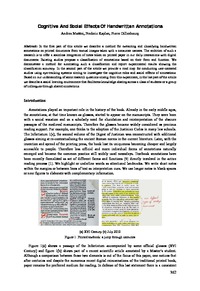Cognitive And Social Effects Of Handwritten AnnotationsZu finden in: red-conference (Seite 362 bis 372), 2011
 |
 |
 Diese Seite wurde seit 6 Jahren inhaltlich nicht mehr aktualisiert.
Unter Umständen ist sie nicht mehr aktuell.
Diese Seite wurde seit 6 Jahren inhaltlich nicht mehr aktualisiert.
Unter Umständen ist sie nicht mehr aktuell.
 Zusammenfassungen
Zusammenfassungen
 In the first part of this article we describe a method for extracting and classifying handwritten annotations on printed documents from textual images taken with a consumer camera. The ambition of such a research is to offer a seamless integration of notes taken on printed paper in our daily interactions with digital documents. Existing studies propose a classification of annotations based on their form and function. We demonstrate a method for automating such a classification and report experimental results showing the classification accuracy. In the second part of the article we provide a road map for conducting user-centered studies using eye-tracking systems aiming to investigate the cognitive roles and social effects of annotations. Based on our understanding of some research questions arising from this experiment, in the last part of the article we describe a social learning environment that facilitates knowledge sharing across a class of students or a group of colleagues through shared annotations.
In the first part of this article we describe a method for extracting and classifying handwritten annotations on printed documents from textual images taken with a consumer camera. The ambition of such a research is to offer a seamless integration of notes taken on printed paper in our daily interactions with digital documents. Existing studies propose a classification of annotations based on their form and function. We demonstrate a method for automating such a classification and report experimental results showing the classification accuracy. In the second part of the article we provide a road map for conducting user-centered studies using eye-tracking systems aiming to investigate the cognitive roles and social effects of annotations. Based on our understanding of some research questions arising from this experiment, in the last part of the article we describe a social learning environment that facilitates knowledge sharing across a class of students or a group of colleagues through shared annotations. Dieses Konferenz-Paper erwähnt ...
Dieses Konferenz-Paper erwähnt ...
 Begriffe KB IB clear |  Perceptron
, Schreibenwriting
, Perceptron
, Schreibenwriting
,  Schreiben von Hand Schreiben von Hand hand writing
, hand writing
,  Schrift Schrift
|
 Dieses Konferenz-Paper erwähnt vermutlich nicht ...
Dieses Konferenz-Paper erwähnt vermutlich nicht ... 
 Nicht erwähnte Begriffe | Schreiben am Computer |
 Tagcloud
Tagcloud
 Volltext dieses Dokuments
Volltext dieses Dokuments
 Anderswo suchen
Anderswo suchen 
 Beat und dieses Konferenz-Paper
Beat und dieses Konferenz-Paper
Beat hat Dieses Konferenz-Paper während seiner Zeit am Institut für Medien und Schule (IMS) ins Biblionetz aufgenommen. Beat besitzt kein physisches, aber ein digitales Exemplar. (das er aber aus Urheberrechtsgründen nicht einfach weitergeben darf). Aufgrund der wenigen Einträge im Biblionetz scheint er es nicht wirklich gelesen zu haben. Es gibt bisher auch nur wenige Objekte im Biblionetz, die dieses Werk zitieren.









 , 805 kByte)
, 805 kByte)  Biblionetz-History
Biblionetz-History